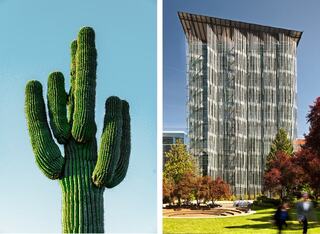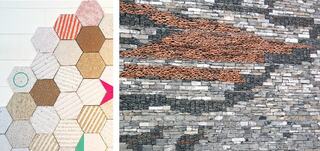Design Through the Lens of Biomimicry

The wisdom of nature and its delicate beauty has long influenced art and design. It changes with the seasons, adapts to sunlight, temperature and rain, and has done so for thousands of years.
Nature adapts to the earth’s cyclical processes, and so can our buildings.
Enter Biomimicry, the concept of consciously emulating nature’s genius by mimicking forms, processes and systems. Formally introduced in the 1950s, there are examples of humans using biomimicry for a lot longer — learning from organisms and acting in concert with nature.
There are great benefits in biomimicry, but first let’s explore how we can use it:
Nature at Three Scales
Biomimicry can be implemented at many different levels, all of which present design opportunities and strategies for using resources efficiently and producing less waste.
Visible Scale
In a visible scale, which the human eye can observe, we see nature evolves in all unique shapes and forms. These shapes and forms help organisms protect and sustain themselves. Similarly, a building envelope protects its interior space. Learning nature’s shapes and forms can help us rethink how our building envelope can enclose its interior.
For example, the Saguaro cactus’ deep vertical profile allows it to self-shade. The deep profile also promotes air circulation between the inner cooler zone and the outer warmer zone, further cooling down the plant. The vertical fins we can use on a building façade for east-west shading is very similar to the cactus’ profile.

Micro Scale
Zooming into the micro scale, an organism’s phylogenetic behaviors evolve to help it survive and to reproduce. By understanding a material’s micro scale composition and reactions, we can implement natural properties into a building’s response to its environment.
Water Reaction, by Chao Chen at the Royal College of Art, is a project inspired by the pine cone, in which the designer attempts to create a material that reacts to external conditions on its own. A pine cone has two layers, and when it gets wet, the outer layer elongates more than the inner layer, causing the petals to enclose the pine cone.
Imagine if this mechanism is fully actualized for use as building cladding or a canopy. The skin would allow building to close its outer shell when it rains, and to reopen when sunny/dry conditions return.
System Scale
At last, we want to bring ourselves up to the air, to see ourselves, our buildings, and our cities as a system. If we compare our built environment with the ecological environment, we can see one of the most pronounced differences is how we deal with waste.
Nature treats waste as a form of resource, and operates in a zero-waste system. Similarly, natural building materials can be reused to eliminate the energy embodied in harvesting and manufacturing new products.
One example is the reuse of broken-down materials for finishes and building envelopes. Take historical building tiles and fixtures: designers can — and do — use bits of these salvaged materials as part of a new mix. Just like nature, when an organism reaches the end of life, it is broken down and returns to the natural system, serving a new life.

Drawbacks and Benefits
So why isn’t biomimicry widely used in the architectural design?
First, a true biomimicry design would act or perform like the organism it is mimicking. For a building project, limitations in our current knowledge, and regulations around design, make it challenging to apply an organism’s strategy to the entirety of a building. Second, biomimicry design usually involves a biologist or a biomimicry consultant on the design team – thus inflating the design fee and potentially creating a longer project schedule.
Currently, biomimicry is mostly used in the product design world, on the material level. Our staff touched on this in No Surprise Guests: Using Nature to Curb Contagions in Hotels.
Although there are challenges to actualizing biomimicry design in all projects right away, we believe it’s time for us to rethink our relationship with the nature. We should reevaluate our roles and impacts on the earth, and humble ourselves to observe nature’s own solutions — right before us.
By employing this concept and its methods, we can foster a healthier coexistence with nature, and design with less impact.
For more information visit some of our favorite resources:
Have a favorite instance of biomimicry in the world? Share with us!


